Papers by Daniela Golinelli

Objectives: HIV is a serious epidemic among homeless persons, where rates of infection are estima... more Objectives: HIV is a serious epidemic among homeless persons, where rates of infection are estimated at three times higher than in the general population. HIV testing is an effective tool for reducing HIV transmission and for combating poor HIV/AIDS health outcomes that disproportionately affect homeless persons, however, little is known about the HIV testing behavior of homeless men. This study examined the association between individual (HIV risk) and structural (service access) factors and past year HIV testing. Methods: Participants were a representative sample of 305 heterosexually active homeless men interviewed from meal programs in the Skid Row region of LA. Logistic regression examined the association between past year HIV testing and demographic characteristics, HIV risk behavior, and access to other services in Skid Row in the past 30 days. Results: Despite high rates of past year HIV testing, study participants also reported high rates of HIV risk behavior, suggesting th...

Heterosexual sex is a significant source of HIV risk among the homeless population, yet little is... more Heterosexual sex is a significant source of HIV risk among the homeless population, yet little is known about the belief systems and sexual experiences of homeless men who have sex with women. This study reports the results of semi-structured interviews with 30 randomly sampled men using shelters or meal lines in downtown Los Angeles. Men ranged in age from 22 to 54 (mean=44), and most (n=22) self-identified as African American. Interviewers collected narratives of two contrasting sexual events - usually one with a condom and one without - using a novel grid-based technique to obtain five key dimensions - social context, sexual behavior, thoughts and feelings, condom use, substance use - across four stages of the sexual event set-up, pre-intimacy, intimacy, post-intimacy. We used Atlas.ti to code interviews and contrasted the characteristics of high and low risk sexual events. Respondents reported a wide variety of patterns of sexual activity and beliefs about HIV risk. A minority o...
Sex Roles, 2009
Impoverished women worldwide are at high risk for contracting HIV/AIDS. This study explores how h... more Impoverished women worldwide are at high risk for contracting HIV/AIDS. This study explores how homeless women make risky sex decisions and the role that alcohol and drugs play in this process. We analyze 56 in-depth qualitative descriptions of recent sexual episodes among 28 women living in shelters in Los Angeles, California, USA. The sample (age 18-63) was 46% African American, 21% Hispanic/Latina, and 21% white. Findings suggest that: (1) homeless women engage in multiple types of relationships and sexual behaviors; (2) emotion and attachment play critical roles in women's risky sex choices; and (3) the role of alcohol and drugs on such choices varies across relationship commitment. Understanding the complexity of sexual decision-making among this population has implications for developing successful risk reduction interventions.
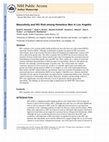
Psychology of Men & Masculinity, 2013
HIV continues to be a serious public health problem for men who have sex with women (MSW), especi... more HIV continues to be a serious public health problem for men who have sex with women (MSW), especially homeless MSW. Although consideration of gender has improved HIV prevention interventions, most of the research and intervention development has targeted how women's HIV risk is affected by gender roles. The effect of gender roles on MSW has received relatively little attention. Previous studies have shown mixed results when investigating the association between internalization of masculine gender roles and HIV risk. These studies use a variety of scales that measure individual internalization of different aspects of masculinity. However, this ignores the dynamic and culturally constructed nature of gender roles. The current study uses cultural consensus analysis (CCA) to test for the existence of culturally agreed upon masculinity and gender role beliefs among homeless MSW in Los Angeles, as well as the relationship between these beliefs and HIV-related behaviors and attitudes. Interviews included 30 qualitative and 305 structured interviews with homeless MSW in Los Angeles's Skid Row area. Analysis identified culturally relevant aspects of masculinity not represented by existing masculinity scales, primarily related to barriers to relationships with women. Behaviors, attitudes, and knowledge related to HIV were significantly associated with men's level of agreement with the group about masculinity. The findings are discussed in light of implications for MSW HIV intervention development.

Perspectives on Sexual and Reproductive Health, 2012
CONTEXT-Pregnancy rates are substantially higher among homeless youth than in the general populat... more CONTEXT-Pregnancy rates are substantially higher among homeless youth than in the general population of youth, yet little is known about homeless adolescents' and young adults' pregnancyrelated attitudes and behaviors. METHODS-Pregnancy-related attitudes and behaviors were examined among two samples of sexually active homeless 13-24-year-olds in Los Angeles County. Data from 37 semistructured interviews conducted in March-April 2011 were analyzed using standard qualitative methods. Data from a structured survey with 277 respondents, conducted between October 2008 and August 2009, were analyzed primarily using regression modeling. RESULTS-More than half of interview respondents held ambivalent attitudes toward pregnancy, and ambivalent youth reported less contraceptive use than others. The interviews identified several potential influences on pregnancy attitudes: barriers associated with homelessness, readiness to settle down, desire to achieve goals, belief that a child would create something positive in life, and family and partners. In the survey, having positive attitudes toward pregnancy was positively associated with duration of homelessness (odds ratio, 1.6), contact with relatives (1.1) and relationship commitment (1.8); it was negatively associated with frequency of drinking (0.9). Relationship commitment was positively associated with nonuse of an effective contraceptive method at last sex (1.5). for homeless youth are needed. Youths' ambivalence toward pregnancy and feelings of relationship commitment warrant attention as possible areas for programs to address. Pregnancy among U.S. adolescents has fallen steadily since the early 1990s. 1 Despite this encouraging trend, pregnancy rates among homeless youth have remained substantially higher than those of the general population of youth. One nationally representative study found that among females 14-17 years old, 48% of those living on the street and 33% of those living in shelters had ever been pregnant, compared with 7% of those who were stably housed. 2 Regional samples have yielded similar findings. It is not surprising that homeless youth have relatively high lifetime pregnancy rates, given that they are more likely than housed youth to be sexually active and that they tend to initiate sex at a younger age. Studies of homeless youth also tend to show that they have relatively high rates of multiple partnerships, transactional sex and unprotected sex. Furthermore, several socioeconomic and psychosocial characteristics that are associated with pregnancy in populations of housed adolescents-poverty, 10,11 alcohol and drug abuse, poor mental health, 11,14 history of childhood physical or sexual abuse, and minority race or ethnicity -are more prevalent among homeless than among housed
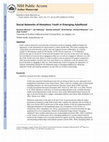
Journal of Youth and Adolescence, 2011
Little is known about the social networks of homeless youth in emerging adulthood despite the imp... more Little is known about the social networks of homeless youth in emerging adulthood despite the importance of this information for interventions to reduce health risks. This study examined the composition of social networks, and the risks and supports present within them, in a random sample of 349 homeless youth (33.4% female, 23.9% African American, 17.7% Hispanic) between the ages of 18 and 24. Social network members who were met on the street were among the most likely to be perceived as engaging in risky sex, as well as to engage in substance use with the youth. Youth were more likely to count on relatives and sex partners for support compared to other network members, but they also were more likely to use substances with sex partners and perceived them as engaging in risky sex. Interventions may need to recognize the importance of intimate relationships during the developmental stage of emerging adulthood by enhancing supportive bonds and reducing substance use and risky sex in these relationships.
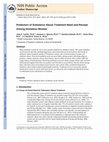
Journal of Substance Abuse Treatment, 2011
Many homeless women do not receive needed treatment for substance abuse. This study identified so... more Many homeless women do not receive needed treatment for substance abuse. This study identified social network and other predisposing factors associated with perceived need for and receipt of substance abuse treatment among 273 homeless women who screened positive for past year substance abuse. Perceived treatment need was more likely among women with drug-using sex partners, a denser network, and an arrest history, but less likely for those with a minor child and longer history of homelessness. Receiving treatment was more likely among women who received informational support from their sex partners and who had an arrest history, but less likely among those who had a more street-based social network, had a minor child, considered themselves homeless, and recently needed mental health treatment. Treatment services researchers should attend more closely to social contextual factors, as well as the more traditional individual factors, to understand access and barriers to treatment.

Journal of Adolescent Health, 2012
Purpose-There is growing interest in network-based interventions to reduce HIV sexual risk behavi... more Purpose-There is growing interest in network-based interventions to reduce HIV sexual risk behavior among both homeless youth and men who have sex with men (MSM). The goal of this study is to better understand the social network and individual correlates of sexual risk behavior among homeless MSM youth in order to inform these HIV prevention efforts. Methods-A multi-stage sampling design was used to recruit a probability sample of 121 homeless MSM youth (ages 16-24) from shelters, drop-in centers, and street venues in Los Angeles County. Face-to-face interviews were conducted. Due to the different distributions of the three outcome variables, three distinct regression models were needed: ordinal logistic regression for unprotected sex; zero-truncated Poisson regression for number of sex partners; and logistic regression for any sex trade. Results-Homeless MSM youth were less likely to engage in unprotected sex and had fewer sex partners if their networks included platonic ties to peers who regularly attended school, and had fewer sex partners if most of their network members were not heavy drinkers. Most other aspects of network composition were unrelated to sexual risk behavior. Individual predictors of sexual risk behavior included being older, Hispanic, lower education, depressive symptoms, less positive condom attitudes, and sleeping outdoors because of nowhere else to stay. Conclusions-HIV prevention programs for homeless MSM youth may warrant a multipronged approach that helps these youth strengthen their ties to prosocial peers, develop more positive condom attitudes, and access needed mental health and housing services.

Drug and Alcohol Dependence, 2009
Background-Substance use poses a significant threat to the health of women, and homeless women ar... more Background-Substance use poses a significant threat to the health of women, and homeless women are more likely to use alcohol and drugs than other women. Addressing risk factors in this population requires a focus on the social context of substance use among homeless women. Methods-Participants were 445 homeless women who were randomly sampled and interviewed in shelter settings about the characteristics of their personal networks. Binomial logistic regressions predicted days of binge drinking and of using marijuana, crack, cocaine, and methamphetamine or other amphetamines in the past 6 months. Results-Homeless women with a greater proportion of heavy alcohol users in their personal networks had greater odds of engaging in binge drinking, and women with a greater proportion of drug users in their networks had greater odds of using marijuana, cocaine, crack, and methamphetamine or other amphetamines. Women with a greater proportion of individuals in their networks that they had met in school or through work had lower odds of marijuana, cocaine, and crack use. Conclusions-Findings suggest the importance of structural solutions in addressing homeless women's alcohol and drug use, including greater access to treatment and recovery support for alcohol and drug problems as well as depression, and enhancing employment and educational, opportunities for homeless women.

Community Mental Health Journal, 2014
There is significant unmet need for mental health treatment among homeless men, but little is kno... more There is significant unmet need for mental health treatment among homeless men, but little is known about the correlates of treatment utilization in this population. Within the framework of the Behavioral Model for Vulnerable Populations, this study examines predisposing, enabling and need factors that may be associated with mental health care utilization. Participants were a representative sample of 305 heterosexually active homeless men utilizing meal programs in the Skid Row region of LA. Logistic regression examined the association between predisposing, enabling and need factors and past 30 day mental health service utilization on Skid Row. Results indicated that while need, operationalized as positive screens for posttraumatic stress disorder or depression, was associated with recent mental health care utilization, predisposing and enabling factors were also related to utilization. African-American homeless men, and those men who also reported substance abuse treatment and drop-in center use, had increased odds of reporting mental health care utilization.
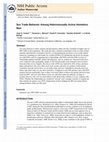
Archives of Sexual Behavior, 2013
Sex trade behavior is fairly common among homeless adults and may contribute to higher rates of H... more Sex trade behavior is fairly common among homeless adults and may contribute to higher rates of HIV/AIDS in this population. This study provides a detailed examination of the sex trade-related attitudes and behaviors of homeless men by: (1) determining the prevalence of sex trade-related behaviors, including sex with female sex workers (FSWs); (2) identifying risk factors for having sex with FSWs; and (3) comparing men's relationships with FSWs and non-FSWs in terms of relationship qualities and HIV-related risk behaviors, such as condom use. Structured interviews were conducted with a probability sample of 305 heterosexually active homeless men recruited from meal lines in Los Angeles. Recent sex with a FSW was reported by 26% of men, and more likely among those who were older, used crack cocaine, had more sex partners, believed that sometimes men just need to have sex no matter what, and were embedded in networks that were denser and where risky sex was more normative. Compared to non-FSW partners, men with FSW partners felt less emotionally close to them, were more likely to believe the partner had never been tested for HIV, and were more likely to have sex with them under the influence of drugs or alcohol; however, they were not more likely to talk about using condoms or to use condoms with FSWs. Whether the relationship was considered "serious" was a stronger correlate of condom use than whether the partner was a FSW. Implications of these findings for HIV prevention efforts among homeless adults are discussed.

AIDS Patient Care and STDs, 2007
We sought to examine whether diffusion of new HIV technologies differed by gender in the United S... more We sought to examine whether diffusion of new HIV technologies differed by gender in the United States, the source of any such disparities, and whether disparities narrow over time as technologies become more established. In particular, we assess how rates of use of highly active antiretroviral therapy (HAART) varied between males and females during the late 1990s, when HAART was rapidly diffusing. We examined data from a prospective cohort study of a national probability sample of 1421 HIV-infected adults in medical care who were enrolled in the HIV Cost and Services Utilization Study (HCSUS) from January 1996 to December 1998. We found that HAART use substantially increased between 1996 and early 1998 for all groups. Women were less likely to receive HAART at all time points, although the diffusion of HAART between 1996 and 1998 reduced gender disparities. Gender disparities in 1998 were only partially explained by women's lower income and educational levels. We conclude that HAART therapy diffused more slowly to HIV-positive females than other groups. Policies that reduce the impact of income and education inequalities on health care may help to narrow gender disparities for new HIV technologies, but other factors may also disadvantage women.

AIDS and Behavior, 2012
This study uses an event-based approach to examine individual, relationship, and contextual corre... more This study uses an event-based approach to examine individual, relationship, and contextual correlates of heterosexual condom use among homeless men. Structured interviews were conducted with a predominantly African American sample of 305 men recruited from meal lines in the Skid Row area of Los Angeles. Men reported on their most recent heterosexual event involving vaginal or anal intercourse. Adjusting for demographic characteristics only, condom use was more likely when men had higher condom use self-efficacy, greater HIV knowledge, or talked to their partner about condoms prior to sex. Condom use was less likely when men held more negative attitudes towards condoms, the partner was considered to be a primary/serious partner, hard drug use preceded sex, or sex occurred in a public setting. Condom attitudes, self-efficacy, partner type, and communication were the strongest predictors of condom use in a multivariate model that included all of the above-mentioned factors. Associations of unprotected sex with hard drug use prior to sex and having sex in public settings could be accounted for by lower condom self-efficacy and/or less positive condom attitudes among men having sex under these conditions. Results suggest that it may be promising to adapt existing, evidence-based IMB interventions for delivery in non-traditional settings that are frequented by men experiencing homelessness to achieve HIV risk reduction and thus reduce a significant point of disparity for the largely African American population of homeless men.
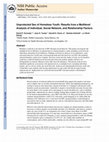
AIDS and Behavior, 2012
Homeless youth have elevated risk of HIV through sexual behavior. This project investigates the m... more Homeless youth have elevated risk of HIV through sexual behavior. This project investigates the multiple levels of influence on unprotected sex among homeless youth, including social network, individual, and partner level influences. Findings are based on analyses of an exploratory, semistructured interview (n=40) and a structured personal network interview (n=240) with randomly selected homeless youth in Los Angeles. Previous social network studies of risky sex by homeless youth have collected limited social network data from non-random samples and have not distinguished sex partner influences from other network influences. The present analyses have identified significant associations with unprotected sex at multiple levels, including individual, partner, and, to a lesser extent, the social network. Analyses also distinguished between youth who wished they used condoms after having unprotected sex and youth who did not regret having unprotected sex. Implications for social network based HIV risk interventions with homeless youth are discussed.

AIDS and Behavior, 2011
Sexual concurrency poses significant HIV/STI transmission risk. The correlates of concurrency hav... more Sexual concurrency poses significant HIV/STI transmission risk. The correlates of concurrency have not been examined among homeless men. A representative sample of 305 heterosexually active homeless men utilizing meal programs in the Skid Row area of Los Angeles reported on their mental health, substance use, and social network characteristics. Nearly 40% of men reported concurrency with one of their four most recent sex partners. Results indicated that HIV seropositivity (OR = 4.39, CI: 1.10, 17.46; p = 0.04), PTSD (OR = 2.29, CI: 1.05, 5.01; p = 0.04), hard drug use (OR = 2.45, CI: 1.07, 5.58; p = 0.03), and the perception that network alters engage in risky sex (OR = 3.72, CI: 1.49, 9.30; p = 0.01) were associated with increased odds of concurrency. Programs aimed at reducing HIV/STI transmission in this vulnerable population must take into account the roles that behavioral health and social networks may play in sexual concurrency.
AIDS and Behavior, 2005
This product is part of the RAND Corporation reprint series. RAND reprints present previously pub... more This product is part of the RAND Corporation reprint series. RAND reprints present previously published journal articles, book chapters, and reports with the permission of the publisher. RAND reprints have been formally reviewed in accordance with the publisher's editorial policy, and are compliant with RAND's rigorous quality assurance standards for quality and objectivity. This PDF document was made available from www.rand.org as a public service of the RAND Corporation.

Addiction, 2013
AimsTo identify characteristics of social network members with whom homeless youth engage in drin... more AimsTo identify characteristics of social network members with whom homeless youth engage in drinking and drug use.DesignA multi‐stage probability sample of homeless youth completed a social network survey.SettingForty‐one shelters, drop‐in centers and known street hangouts in Los Angeles County.ParticipantsA total of 419 homeless youth, aged 13–24 years (mean age = 20.09, standard deviation = 2.80).MeasurementsRespondents described 20 individuals in their networks, including their substance use and demographics, and the characteristics of the relationships they shared, including with whom they drank and used drugs. Dyadic, multi‐level regressions identified predictors of shared substance use.FindingsShared drinking was more likely to occur with recent sex partners [odds ratio (OR) = 2.64, confidence interval (CI): 1.67, 4.18], drug users (OR = 4.57, CI: 3.21, 6.49), sexual risk takers (OR = 1.71, CI: 1.25, 2.33), opinion leaders (OR = 1.69, CI: 1.42, 2.00), support providers (OR = ...











Uploads
Papers by Daniela Golinelli